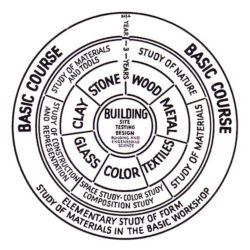Rebel. Artist. Disrupter. Visionary. Master.
Walter Gropius.
This man changed architecture, brought back DesignBuild and moved the entire building design and construction industry in an entirely new direction. He took on fixed ideas, entrenched interests and the stultified halls of Academia. A man with a color brush of truth and aesthetic creativity in the academic corridors of black and white.
Walter versus Goliath — if you will.
He is a Master by definition.
You well may have never heard of him. Unless you are an architectural student or professional in the industry this is likely the case.
Conversely, if you ARE an architect, designer or professional in the building industry, you very likely have heard of Walter Gropius and have encountered or studied his work. There is likely more to the life, story and impact of Walter Gropius(1883-1969) than you know. He is one of the most well-known architects ever, and many recognize him as a pioneer of the impactful modern style. That being said, there are facts about him very few know, and this is not by chance.
After some study, research and personal experience, I am proud to bring the truth of this incredible man’s intentions and actions to you.
Let’s take a look:
To start, let’s recap on what you may already know, or at least recognize.
Walter Gropius was born in Berlin, Germany on 18 May, 1883. He established himself as a founder of the Modern Style in the elite ranks with Frank Lloyd Wright and other legends such as Mies van der Rohe and Le Corbusier.
Modern Architecture came from the urge to breakaway from imitating architectural styles of the past coupled with advancements in building materials; most notably – cast iron, plate glass and reinforced concrete. These materials allowed buildings to be stronger, lighter and taller. Modernists such as Gropius wanted to reflect the purpose of these materials in the buildings themselves, emphasizing the famous motto “form follows function,” said by Louis Sullivan.
Architects & Builders, rightly so, are recognized for the buildings they leave behind, as it is this legacy which serves mankind into the future. The above picture may be familiar to many — particularly anyone who has ever taken an architectural history class. This building represents the advent of the modern style–of which Gropius would be internationally renowned for.
In what would prove to be a defining moment, Gropius stepped forward to found the Bauhaus school in 1919. This was the proverbial flag plant which would define his further life, values and message to mankind.
Form follows Function, was in fact made popular by the Bauhaus school. This school taught a design philosophy distinctly different than that primarily espoused at the time, led by the Ecole de Beaux Arts of France (National School of Fine Arts in France), which had become highly theoretical, and in practice was creating in academia an artist separate from the artisan.
Take a moment to look at and grasp the importance of that simple concept: An academic artist separate from the artisan.
An arbitrary fracture of both theory and doingness.
The integrity of theory and doingness as one — in the creation of aesthetic and powerful structures is what has truly defined the Master since the beginning of time.
Never before unearthed and documented as I am here is the ethos behind the Modern Movement. These principals are very close to my heart and what I strive to live for, promote and achieve for my clients. For myself it’s personal rather than theoretical, as it defines how I bring meaning to the world and impact the families, businessmen, groups and individuals that I serve. At the core of the Modern Movement was a DesignBuild Movement. A meaningful stride away from the academic distinction between the so-called fine arts and so-called applied arts or crafts. To start to peel this onion one only needs to understand the name Gropius gave his school.
The name Bauhaus comes from the German word Bauhütte, which means – building hut. The “Bauhaus” or building hut is analogous to the construction job site trailer of today with the primary difference being that previously there were no dividing lines between the designer and builder; they were one and the same.
Bauhaus was a small workshop erected on site at the start of a project to be where the “Master” would direct and work together with the other trade masters.
Now this term “Master” is immensely significant. It has been around since time immemorial and is still used much the same way in the trade crafts and professional spheres of today. It defines the succession from apprentice, to journeyman (a skilled tradesman qualified to work independently) to the highest level in one’s profession – a Master.
The derivation of the word “architect” actually breaks down to Master (Arcki) Builder (Tecton).
This is what Gropius intended to get back to. Clear from his written words in the 1919 Bauhaus manifesto:
“The old art schools… must be merged once more with the workshop. This world of mere drawing and painting of draftsmen and applied artists must at long last become a world that builds. If the young person who senses within himself a passion for creative practice begins his career, as in the past, by learning a trade, then the unproductive ‘artist’ will no longer be condemned to imperfect artistry because his skill will be preserved in craftsmanship, where he may achieve excellence. Architects, sculptors, painters, we all must return to the crafts! There is no essential difference between the artist and the craftsman. The artist is an exalted craftsman. Merciful heaven, in rare moments of illumination beyond man’s will, may allow art to unconsciously blossom from the work of his hand, but the foundations of craft are indispensable to every artist. This is the original source of creative design. So let us then create a new guild of craftsmen, free of the divisive class pretensions that attempted to raise an arrogant barrier between craftsmen and artists! Let us together will, conceive, and create the new building of the future.”
Gropius backed these words up with a curriculum that was wholly DesignBuild as he artfully portrayed in graphic form as a wheel.

To break the above curriculum wheel down – this full DesignBuild course covered three periods:
1. A Basic Course, lasting six months, which consisted of elementary training in design and then experiments with different materials in the special “Basic” Workshop.
2. Technical Instruction as a legally bound Apprentice in one of the seven Training Workshops – carpentry (wood), metal, weaving (textile), wall painting (color), glass, pottery (clay), sculpture (stone). While concurrently being supplemented by more advanced instruction in design, this lasted three years–at the end of which the pupil obtained his Journeyman’s Certificate, providing he had achieved and demonstrated adequate proficiency.
3. Building Site Instruction was for especially promising pupils–for approximately two years. This consisted of an alternation between manual work on actual building sites and continued theoretical training in the Bauhaus. At the end of this period the pupil (if proficient enough) obtained his Master-Builder’s Diploma.
So, in a span of three and a half years, one would start their career as a journeyman artisan or continue on to be a Master-Builder. Why is this then not the basis for how an architect is trained today?
Dave.
This is the first part of our two-part blog series on Walter Gropius. For part two, please click here.
References:
https://en.wikipedia.org/wiki/Bauakademie
https://www.peoplesworld.org/article/100-years-of-bauhaus-building-for-a-society-of-equals/
https://www.getty.edu/research/exhibitions_events/exhibitions/bauhaus/new_artist/
https://www.thecrimson.com/article/1952/2/23/hudnut-drops-design-1-based-on/
https://www.thecrimson.com/article/1952/9/15/gropius-resignation-bares-design-school-hassel/
https://en.wikipedia.org/wiki/Journeyman
https://study.com/academy/lesson/modernism-in-architecture-definition-history.html
https://en.wikipedia.org/wiki/Walter_Gropius


Comments are closed here.